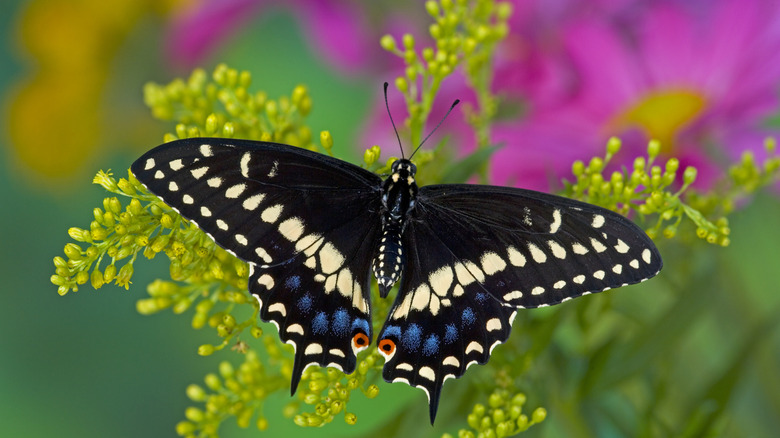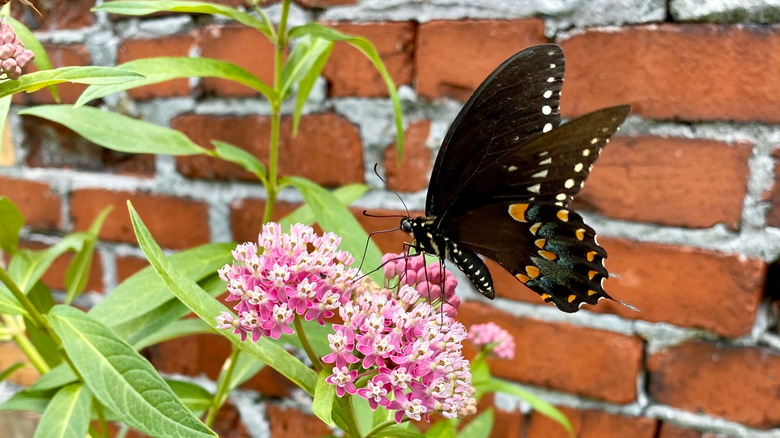Plant One Popular Herb To Fill Your Garden With Beautiful Butterflies
If you want a garden filled with butterflies this summer, start by filling your garden beds with the plants they love. One of the easiest to grow plants to get your butterfly garden off to a good start is dill. The common culinary herb will attract butterflies to your garden who use the aromatic plant as a host for their caterpillars. Specifically, the caterpillars of the Black Swallowtail and Anise Swallowtail butterflies feed on the leaves of dill (Anethum graveolens).
The feathery foliage grows up to 3 feet tall and adds great texture to a garden bed. You can plant it as a butterfly-friendly border or mix it in with other herbs like parsley and cilantro for a culinary herb garden that you and the caterpillars can both enjoy. Though, if you plan to harvest some of the dill for yourself, consider planting two patches of the herb. If you ever spot a caterpillar on the dill you're reserving for yourself, pluck it off and move it over to the patch you're growing for the butterflies. For best results, plant a mix of herbs and flowers along with your dill to attract a variety of other butterflies along with your Swallowtails. With a mix of host plants like dill that feed larvae and nectar plants that feed the adults, your garden will be filled with butterflies all season long.
Tips for planting dill to attract butterflies
Dill is an adaptable herb that can be grown in zones 2 through 11. So, it's a great choice for attracting butterflies to just about any garden in any climate. With that said, gardeners in hotter climates should plant dill in a bed that gets part shade to protect it from the heat. It can tolerate poor soil, but you'll get the best growth if you plant it in well-draining soil with plenty of organic matter.
Just remember that when you spot those green and yellow critters feasting on your dill, they're future butterflies, not pests to be eradicated. In fact, if your main goal is attracting more butterflies to your garden, you should avoid using pesticides altogether. Even if you spray them elsewhere or before the butterflies show up, some can linger or drift beyond where you sprayed, harming pollinators months or years later. Instead, focus on attracting predators that eat the pests your dealing with or use non-chemical control methods like physical barriers and hand removal to keep troublesome pests at bay.
Lastly, to help your dill last through the growing season despite being feasted on, check regularly for plants that might have too many caterpillars on it. Pluck a few off by hand and move them to other plants that don't have as many. You can also sow seeds in batches every two to three weeks in spring and early summer to create a continuous succession of fresh dill plants to host multiple generations of swallowtail caterpillars.
Dill companion plants to create a butterfly oasis
Black Swallowtails can generally produce two or three generations over the course of a single growing season. Planting dill is a great way to encourage them to lay their eggs in your garden, but its flowers don't produce much nectar for the adults to eat. So, if you want the adult Black Swallowtail butterflies to stick around after emerging from their cocoons, be sure to mix some nectar plants that will attract butterflies looking for a meal.
Aim for a mix of flowers that bloom at different times so you'll have nectar available for butterflies all through the growing season. Some swallowtail favorites include golden Alexanders, Joe Pye weed, purple coneflower, and milkweed. They also like clover and phlox. One benefit of planting nectar plants like these along with your dill is that they attract even more butterflies to your garden. Milkweed, for example, is a key plant for Monarch butterflies. The adults enjoy the nectar just as much as Swallowtails while Monarch caterpillars exclusively eat Milkweed foliage.
Just make sure to choose a variety that's native to your area and, above all, avoid the common mistake of planting tropical milkweed (Asclepsia curassavica). Tropical milkweed is a Mexican native that can disrupt Monarch migration if planted outside of Mexico. By searching for milkweeds native to your state or county, you can plant a variety that blooms at the right time for migrating Monarchs — and provide nectar for Swallowtails and other butterflies while you're at it.


